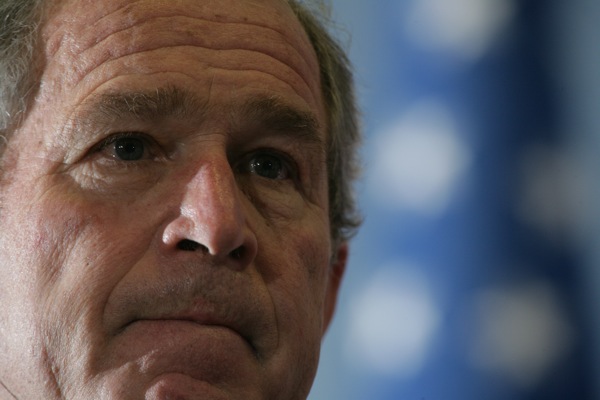A Taxing Challenge
A decade of cuts in federal combined with states mimicking Bush administration tax cuts have led states to fill revenue shortfalls with regressive tax policies.
Jul 31, 2020387 Shares386.8K Views
Former President George W. Bush (Gamma/Eyedea/ZUMA Press)
A decade’s worth of cuts in federal aid combined with states moving to copy Bush administration tax cuts have led to states filling revenue shortfalls with regressive tax policies that disproportionately affect the poorest Americans. According to “Who Pays?” a report issued in November by the Institute on Taxation & Economic Policy, the poorest 20 percent of Americans pay nearly 11 percent of their income in state and local taxes, the majority of which is in the form of sales and excise taxes. Those in the top 1 percent, by contrast, pay just over 5 percent of their income in state and local taxes, and the majority of that is income tax.
[Economy1] “To the extent that states rely on sales tax, they’re going to be regressive,” said Howard Abrams, professor at Emory University School of Law, pointing out that the most regressive states in the ITEP report depend on sales and excise tax revenues to a great degree. Since poor individuals spend rather than save more — or all — of their income, sales tax as well as excise taxes on goods like gasoline and cigarettes impact them to a greater degree. Their wealthier counterparts, by contrast, tend to save and invest, which means every dollar they make isn’t going towards taxable purchases. A graduated income tax is designed to balance this burden by taxing wealthier occupants at a higher rate, but some states have such low thresholds for their top rates, or their rate spread is in such a narrow range, that any benefit to lower-income residents is lost.
The poorest Americans are also burdened by regressive property taxes, said Philip Harvey, professor at Rutgers School of Law. Two factors contribute to this: One, they may live in less-wealthy municipalities that have to tax at a higher rate to provide services. Secondly, many lower-income individuals rent rather than own property. “Economists generally know property taxes tend to be regressive because rent includes taxes indirectly,” Harvey said. Since lower-income people statistically spend a higher percentage of their income on housing, this translates to yet another higher tax burden.
In theory, federal income tax balances out this disparity to an extent because it relies on a graduated formula, but critics of the status quo say the country’s poorest citizens are still suffering from the effects of the Bush tax cuts. “Unambiguously, federal taxes have become less progressive over the last 10 years,” said Kim Rueben, public finance economist at the Urban Institute-Brookings Institution Tax Policy Center.
“One of the big changes during the Bush administration was a substantial reduction on capital gains and dividends,” said Emory’s Howard Abrams. “The only people that got the benefit were the extraordinarily wealthy.” Not only does this rob federal coffers of funds, but it also sets a precedent for states, several of which followed suit with tax cuts of their own.
States’ tendency to mimic federal actions does have a silver lining in that 23 states and Washington, D.C., offer earned-income tax credits modeled after the federal credit. Matthew Gardner, executive director of the ITEP, said credits like these, especially when they are refundable, go a long way towards leveling the playing field for low-income people. These credits aren’t enough, though. “The credits that were introduced under Bush for the poor families were dwarfed by declining tax rates at the top,” said the Tax Policy Institute’s Rueben.
Bush-era cutbacks on federal monies sent to states are equally harmful to poor residents. “There isn’t a lot of redistribution being done at the state and local level,” said Alan Viard, resident scholar at the American Enterprise Institute. “You expect that and want it to be done at the federal level.” Problems crop up when the federal government scales back this involvement. With less aid coming from Washington, states must rely solely on their own residents for funding, which nearly always leads to an increased reliance on regressive tax policies.
The ITEP’s Gardner says he is hopeful that the recession-prompted emergency aid to states will become the new status quo. If the federal government becomes involved to a greater degree in redistributing the tax dollars it takes in, states would have the breathing room to roll back some of their sales and excise tax increases.
Progressive groups are hopeful that the Obama administration will reverse some of these disparities by allowing provisions that cut taxes for the wealthiest Americans to expire next year and in 2011. While this wouldn’t directly change states’ tax structures, these changes to the federal tax code would create a healthier balance for poor as well as middle-class citizens.
According to a report published by the Tax Policy Center, Obama administration proposals would lower the federal tax rates for all but the wealthiest 20 percent of citizens. The net tax rates for all Americans would be the same under Obama’s plan as under an alternate model that assumes the extension of the provisions implemented by Bush; however, the costs in the former case would be shouldered to a much greater degree by the wealthiest citizens. With a federal program like that in place, the inherently regressive nature of most state and local taxes would be less of a burden on those who have already borne an outsized share of this recession’s pain.

Hajra Shannon
Reviewer
Latest Articles
Popular Articles
